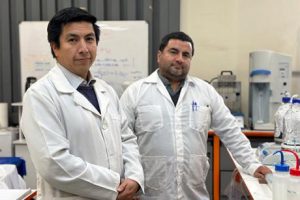The initiative proposes the recovery of nitrogen, phosphorus and sulfur from these waters generated by the anaerobic digesters of pig farms, in order to use them to produce fertilizers, among other potential uses with an impact on the industry.
Paola Armijo, USACh Journalist.- Agro-industries today are betting on the energy recovery of the animal waste they generate, which is processed in hermetic containers or anaerobic digesters.
Said process results in the transformation of this organic material into biogas, which after a purification treatment can provide electricity to the industrial plant.
However, one of the problems associated with this technology is that it fails to remove nutrients from the water, specifically nitrogen, phosphorus and sulfur, which cthey cause bad odors and pollute the environment, among others.
To respond to this problem, the University of Santiago develops research “New system for the recovery of S, P and N from digestates via elemental sulfur (S0) precipitation, struvite and a liquid current rich in ammonium polyacrylate”, which is led by Dr. César Huiliñir Curío, academic and researcher at the Faculty of Engineering.
The project is financed by ANID and supported by the company Albemarleone of the largest lithium producers in the world; AASA Agricultural, dedicated to raising pigs, and by our Vriic Technology Management Department. As explained by Dr. César Huiliñir, “The creation of a system with low economic and environmental impact is proposed, which allows the recovery of these compounds to produce fertilizers”.
To achieve this, the investigation is being carried out in two stages. “In the first, the aim is to create equipment to extract phosphorus, nitrogen and sulfur, from the precipitation of struvite and elemental sulfur, explained Dr. Huiliñir.
Meanwhile, in the second, it is desired to use a polymer-assisted ultrafiltration equipment that removes the excess nitrogen from the current coming from the crystallizer, which could be around 1000 m/l of total ammoniacal nitrogen. This phase is in charge of Dr. Julio Sánchez, alternate director of the project and researcher at the Faculty of Chemistry and Biology.
Another relevant aspect is that the wastewater that remains after anaerobic digestion can be “reused again in the industrial plant, since the liquid will be left with less phosphorus, nitrogen and sulfur.
This project has a duration of two years and will culminate in the second semester of 2024.
“Today we are in the system design stage. Once finished, we will look for a company to build the equipment and then operate it from the laboratory, in order to optimize the obtaining of these components”, summarized Dr. Huiliñir.
Both for the current work and in the application of the technology, the research team has the support of Agricola AASA, which makes its anaerobic digesters available to extract the residues of pig slurry and carry it out for experimentation. “One of the great concerns of this hatchery is to suppress the bad odors that are produced and for this, we are working on the elimination of sulfur,” said the researcher.
For his part, Albemarle it provides magnesium, which is produced as waste during the lithium refining process and which is necessary to generate the struvite that is required in the execution of the research.






![[Img #74853]](https://thelatestnews.world/wp-content/uploads/2025/01/Beginners-Guide-to-iGaming-150x150.jpg)




![[Img #74853]](https://thelatestnews.world/wp-content/uploads/2025/01/Beginners-Guide-to-iGaming-300x200.jpg)

